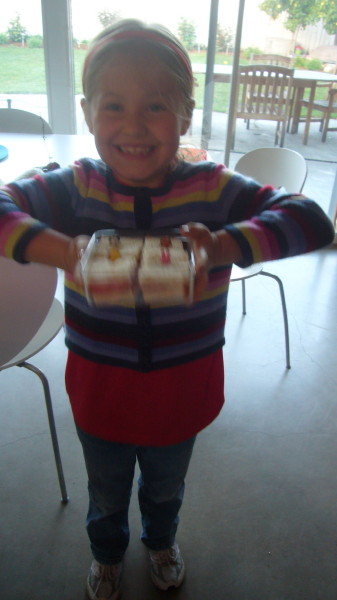By Lisa
The age old wisdom is true: put something in front of your kids–even the pickiest eaters–enough times and they will, very likely, eventually, eat it. It may take 6-months or a year or five or ten (as it did with me and squash, a food I refused to eat in any form for the length of my childhood), but this is the best way to ensure that they are exposed to a range of foods. Hiding food in other food is dumb. It will never teach your kids to like or eat that food, or even to know what that food is. So, my philosophy is that unless your kid is suffering from scurvy or other nutritional deficiency you and your kids should eat real food that looks like what it is.
And I am not speaking theoretically here. In a family of adventurous omnivores, my son Finn went from eating anything we set in front of him to being a defiant picky monochromo-foodist. For about 8-months, when he was around three, he dropped all red, green, yellow, orange food from his diet. He ate white things: Rice. Bananas. Some raw tofu. Baked potato. I actually did resort to plugging him with vitamins until he began, slowly to come out of it, by adding one color back into his diet at a time. I did nothing during this period but continue to put in front of him the same food that we ate every meal. There was nothing else I could do, so stubborn was resistance to eating. So I just refused to cater to him, and he eventually figured it out. Call it the power of implicit suggestion. I don’t, by any means, intend to sound glib here. It was hard. It was really, deeply worrisome. I worried constantly about his health. But it did prove to me that this technique works, and he now eats better than ever.
Ella, on the other hand, is the child who one morning, over breakfast, announced “I had a dream about the most amazing hamburger last night. It was so delicious. It was on a bun, and it had lettuce and tomato. It was so good! When can we have hamburgers?”
This was from a child who had never in her life eaten a hamburger on a bun, and who hadn’t had a hamburger cut up on her plate for six months. Not too long after that, though, she got her dream come true, and now hamburgers, when we cook them on Sundays, from the amazing grass fed meat we buy at our local farmer’s market, is the highlight of her week. Finn thinks they’re pretty great, too.
Which brings me to the latest culinary influence in our home: Harriet the Spy. I’ve written about our cake habit but Harriet has recently and completely infiltrated our lunches in the form of tomato sandwiches. As soon as tomatoes appeared in our market a few weeks ago, Ella snatched some up for her lunch. No matter that she had never had a tomato sandwich before. (Even though they’re our staple adult Sunday lunch all summer long, Harriet, who has been eating tomato sandwiches every day for 5 years, was a much more important factor in Ella’s conversion).
So, I happily made Ella a tomato sandwich and packed her off to school.

And the next day I made another and then another. And another. Now her favorite thing to do on days off or weekends, or when we lunch with dad in his excellent cafeteria at work, is to make herself her own tomato sandwich.
Which brings me to the point of this post, which is not really about feeding your family hamburgers or tomato sandwiches or even about the wisdom of reading books with good food in them, but about the way that our palate is influenced by the culture around us as much as by the actual food in our plates. How we think and talk and read about food absolutely influences our children’s diets, and so does how we present food to them–literally but also imaginatively. Ella and Finn are learning about choice, sure, but they’re also learning about the infinite, lifelong pleasures of the gastronomic imagination.
Desires, dreams, aspirations, expectations, ideals–these things can make us hungry, too. And, the most beautiful thing may be that these are cravings we can, sometimes, truly satisfy.


Nina
April 23, 2009 @ 12:46 pm
Thank you…I think I will have to visit the farmer’s market with my own Ella…
And who is Harriet? An imaginary friend?
caroline
April 23, 2009 @ 2:16 pm
Nina, Harriet the Spy is a children’s novel by Louise Fitzhugh, well worth checking out!
http://en.wikipedia.org/wiki/Harriet_the_Spy
lisa
April 23, 2009 @ 3:32 pm
Also, Nina–it’s an American classic of the mid-1960s, so no wonder it was not part of your early years!;)
Erika
April 23, 2009 @ 9:35 pm
My mother loves telling about how when my sister and I were small she’d make the salad early, set it in the middle of the dining room table and say “don’t touch that” and then commence making the rest of dinner — and apparently we would then “sneak” bites of salad w/the same glee with which one would raid a cookie jar. I don’t remember, but it makes for a good story w/a spin on putting food “in front of” kids.